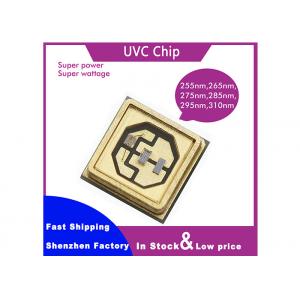High quality sterilizationl use 265nm 280nm 275nm deep uv 3535 UVC LED Chip
Add to Cart

Good Price Sterilizationl Use 265nm 280nm 310nm 275nm Deep UV 3535
UVC LED Chip
| Power | 0.25W or 1W |
| Type | Deep UVC LED |
| Voltage | 5.0-8.0V |
| Current | 40mA or 150mA |
| Chip Brand | LG or Nichia |
| Wavelength | 270-280nm |
| Radiant Power | 2-4mw or 5-10mw |
| Warranty | 2000hours or 1 year |
| Base Material | Aluminum Nitride |
| Wire Material | Pure Gold |
| Applications | 1. Disinfection sterilization 2.Ultraviolet detection,communication technology 3. Air sterilization, water sterilization 4. Medical treatment and skin disease treatment |
Several questions about UVC LED disinfection and UVC wavelength
1.Does the peak absorption wavelength of DNA vary by bacteria?
Yes. Different types of peak absorption wavelengths are indeed
different, but most of them are around 265nm.
2.Can a single wavelength eliminate all bacteria?
Yes, a single wavelength can be used. However, bacteria have
different optimal absorption wavelengths.
3.Can UVC help prevent**** transmission by reducing contamination?
Based on existing evidence, we believe so. Here's why:
UVC light has been used extensively for more than 40 years in
disinfecting drinking water, waste water, air,
pharmaceutical products, and surfaces against a whole suite of
human pathogens (Fluence UV Dose
Required review IUVA). All bacteria and *** tested to date (many hundreds over the
years, including
other ****) respond to UV disinfection. Some organisms are more
susceptible to UVC disinfection than
others, but all tested so far do respond at the appropriate doses.
4.What is the "sterilizing range" of UV?
According to the International Ultraviolet Association, "the
ultraviolet spectrum (the 'sterilization' region)
that is important for water and air disinfection is the range
absorbed by DNA (RNA in some ***).
This sterilization range is about 200-300nm."
It is known that the bactericidal range extends above 280 nm, and
it is now generally considered to
extend to 300 nm, however this may also change with more research.
Scientists have shown that
ultraviolet light with a wavelength between 280nm and 300nm can be
used for disinfection and sterilization.
5.What is the optimal wavelength for disinfection?
There is a misunderstanding that 254nm is the optimal wavelength
for disinfection because the peak
wavelength of a low-pressure mercury lamp (determined solely by the
physics of the lamp) is 253.7nm.
The wavelength of 265 nm is generally considered to be optimal
because this wavelength is the peak
of the DNA absorption curve. However, a range of wavelengths have
disinfection and sterilization effects.
6.Ultraviolet mercury lamps were once considered the best choice for
disinfection
and sterilization. Why is this?
Historically, mercury lamps have been the only option for
disinfection and sterilization. With the
advancement of UV LED technology, there are new options because
LEDs are smaller, more
powerful, non-toxic, longer life, more energy efficient, and allow
more switching times. This
makes the solution smaller, battery-powered, more portable, and
capable of instant full-light output.
7.What is the difference in wavelength characteristics between UVC
LEDs and mercury lamps?
Low-pressure mercury lamps emit nearly monochromatic light with a
wavelength of 253.7 nm. Low-pressure mercury
lamps (fluorescent tubes) and high-pressure mercury lamps are also
used for disinfection and sterilization. These
lamps have a broader spectral distribution, including wavelengths
used for sterilization. UVC LEDs can be focused
on a narrow range of specific wavelengths, which allows the
solution to be tailored to specific application needs.
8.How is the bactericidal effect determined?
Generally, power intensity, wavelength, and duration of irradiation
are used to determine the bactericidal effect.
For example, in water, there may be multiple bacteria with
different optimal absorption wavelengths.
For any given wavelength of germicidal UV, the power and time of
irradiation need to be calculated to achieve
the desired level of disinfection.
9.Are UVC disinfection devices safe?
Like any disinfection system, UVC devices must be used properly to
be safe.) They all produce varying
amounts of UVC light in wavelengths of 200nm-280nm. This UVC light
is much "stronger" than normal sunlight,
and can cause a severe sunburn-like reaction to your skin, and
similarly, could damage the retina of your eye,
if exposed. Some devices also produce ozone as part of their cycle,
others produce light and heat like an arc
welder, others move during their cycles. Hence, general
machine-human safety needs to be considered with
all disinfection devices, and these considerations should be
addressed in the operations manual, in the user
training, and appropriate safety compliance.
10.Are there performance standards and UVC validation protocols for UV
disinfection devices?
Given the wide array of UVC devices marketed for disinfection of
air, water and solid surfaces, the lack of
uniform performance standards and the highly variable degree of
research, development and validation testing
that is performed on different devices, the IUVA urges consumers to
exercise caution when selecting equipment
and look for evidence of third party testing as well as
certification of device materials and electrical components
by well-known organizations such as UL, CSA, DVGW-OVGW or other
international requirements as applicable.
For UVC devices designed to inactivate air and solid surfaces in
the healthcare industry, members of IUVA are
working diligently with other national standards organizations in
the lighting and healthcare industry to develop
disinfection testing standards[x]. The goal is to develop guidance
that will help healthcare providers world-wide
choose the best possible technologies for their institutions to use
in the fight against multiple drug resistant
organisms and other pathogens


 Shenzhen Xingliaoyuan Technology Co., Ltd It's a manufacture in
Shenzhen City.
Shenzhen Xingliaoyuan Technology Co., Ltd It's a manufacture in
Shenzhen City.